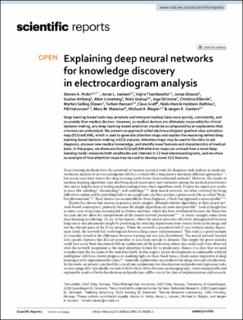| dc.contributor.author | Hicks, Steven | |
| dc.contributor.author | Isaksen, Jonas L | |
| dc.contributor.author | Thambawita, Vajira L B | |
| dc.contributor.author | Ghouse, Jonas | |
| dc.contributor.author | Ahlberg, Gustav | |
| dc.contributor.author | Linneberg, Allan | |
| dc.contributor.author | Grarup, Niels | |
| dc.contributor.author | Strumke, Inga | |
| dc.contributor.author | Ellervik, Christina | |
| dc.contributor.author | Olesen, Morten Salling | |
| dc.contributor.author | Hansen, Torben | |
| dc.contributor.author | Graff, Claus | |
| dc.contributor.author | Holstein-Rathlou, Niels-Henrik | |
| dc.contributor.author | Halvorsen, Pål | |
| dc.contributor.author | Maleckar, Mary Margot Catherine | |
| dc.contributor.author | Riegler, Michael | |
| dc.contributor.author | Kanters, Jørgen K | |
| dc.date.accessioned | 2022-03-25T15:33:25Z | |
| dc.date.available | 2022-03-25T15:33:25Z | |
| dc.date.created | 2021-05-27T12:44:51Z | |
| dc.date.issued | 2021-05-26 | |
| dc.identifier.citation | Scientific Reports. 2021, 11 . | en_US |
| dc.identifier.issn | 2045-2322 | |
| dc.identifier.uri | https://hdl.handle.net/11250/2987743 | |
| dc.description.abstract | Deep learning-based tools may annotate and interpret medical data more quickly, consistently, and accurately than medical doctors. However, as medical doctors are ultimately responsible for clinical decision-making, any deep learning-based prediction should be accompanied by an explanation that a human can understand. We present an approach called electrocardiogram gradient class activation map (ECGradCAM), which is used to generate attention maps and explain the reasoning behind deep learning-based decision-making in ECG analysis. Attention maps may be used in the clinic to aid diagnosis, discover new medical knowledge, and identify novel features and characteristics of medical tests. In this paper, we showcase how ECGradCAM attention maps can unmask how a novel deep learning model measures both amplitudes and intervals in 12-lead electrocardiograms, and we show an example of how attention maps may be used to develop novel ECG features. | en_US |
| dc.description.sponsorship | This work is funded in part by Novo Nordisk Foundation project number NNF18CC0034900. | en_US |
| dc.language.iso | eng | en_US |
| dc.publisher | Nature Research | en_US |
| dc.relation.ispartofseries | Scientific Reports;11, Article number: 10949 (2021) | |
| dc.rights | Navngivelse 4.0 Internasjonal | * |
| dc.rights.uri | http://creativecommons.org/licenses/by/4.0/deed.no | * |
| dc.subject | Cardiology | en_US |
| dc.subject | Machine learning | en_US |
| dc.title | Explaining deep neural networks for knowledge discovery in electrocardiogram analysis | en_US |
| dc.type | Peer reviewed | en_US |
| dc.type | Journal article | en_US |
| dc.description.version | publishedVersion | en_US |
| dc.rights.holder | © The Author(s) 2021 | en_US |
| dc.source.articlenumber | 10949 | en_US |
| cristin.ispublished | true | |
| cristin.fulltext | original | |
| cristin.qualitycode | 1 | |
| dc.identifier.doi | https://doi.org/10.1038/s41598-021-90285-5 | |
| dc.identifier.cristin | 1912226 | |
| dc.source.journal | Scientific Reports | en_US |
| dc.source.volume | 11 | en_US |
| dc.source.issue | 11 | en_US |
| dc.source.pagenumber | 11 | en_US |
| dc.relation.project | Novo Nordisk Fonden: NNF18CC0034900 | en_US |

